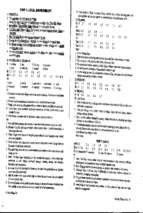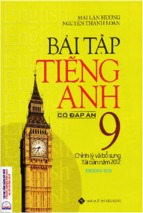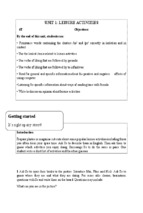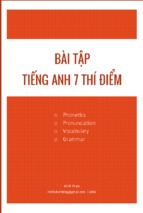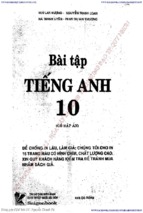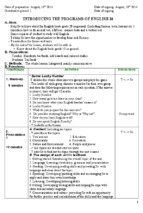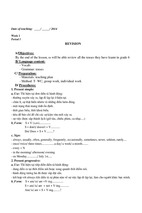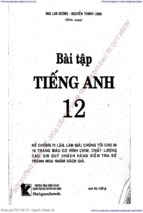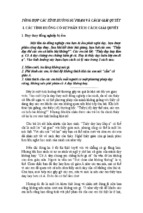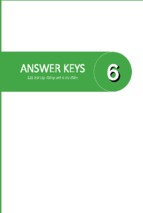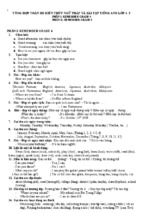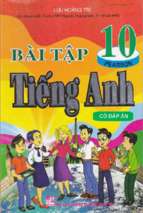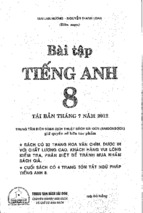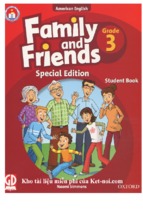1: Read the following passage and mark the letter A, B, C, or D on your answer sheet to choose
the word or phrase that bestfits each ofthe numbered blanks from 1 to 5
Left-handers are the odd ones out. Sure, lefties (1)
up about 10 percent of the
population - but, frankly, it seems like society has forgotten about them. Just consider all of the righthanded gadgets, awkwardly designed desks, and cooking tools that fit comfortably only in your right
hand. What (2)
points to a complex (3)
someone to become a lefthand? Scientists aren’t exactly sure, but research between genes and environment
While no exact set of “leftie genes”
have been discovered, people who dominantly use their left hands do have more left-handed family
members. And researchers have found different brain wirings in righties vs. lefties. But no matter (4)
it is that drives someone to use their antipodal paw, science has also uncovered a particular
set of personality traits that left-handed people tend to have. So for all of you lefties, leftie-loving
righties, and ambidextrous folks out there - it’s time to brush up on your left-handed knowledge and
help (5)
an end to leftie discrimination once and for all.
Question 1: A. consist
B. account
C. hold
D. make
Question 2: A. causes
B. makes
C. gets
D. does
Question 3: A. collaborate
B. collaboration
C. collaborating
D. collaborated
Question 4: A. which
B. who
C. what
D. that
Question 5: A. put
B. bring
C. make
D. take
2: Read the following passage and mark the letter A, B, C, or D on your answer sheet to indicate
the correct answer to each of the questions from 6 to 12.
Successful students often do the followings while studying. First, they have an overview
before reading. Next, they look for important information and pay greater attention to it (which often
needs jumping forward or backward to process information). They also relate important points to one
another. Also, they activate and use their prior knowledge. When they realize that their
understanding is not good, they do not wait to change strategies. Last, they can monitor
understanding and take action to correct or “fix up” mistakes in comprehension.
Conversely, students with low academic achievement often demonstrate ineffective study
skills. They tend to assume a passive role, in learning and rely on others (e.g., teachers, parents) to
monitor their studying, for example, low-achieving students often do not monitor their understanding
of content; they may not be aware of the purpose of studying; and they show little evidence of
looking back, or employing “fix-up” strategies to fix understanding problems. Students who struggle
with learning new information seem to be unaware that they must extent effort beyond simply
reading the content to understand and remember it. Children with learning disabilities do not plan
and judge the quality of their studying. Their studying may be disorganized. Students with learning
problems face challenges with personal organization as well. They often have difficulty keeping
track of materials and assignments, following directions, and completing work on time. Unlike good
studiers who employ a variety of study skills in a flexible yet purposeful manner, low-achieving
students use a restricted range of study skills. They cannot explain why good study strategies are
important for learning; and they tend to use the same, often ineffective study approach for all
learning tasks, ignoring task content, structure or difficulty.
(Source: Adapted from Study Skills: Managing Your Learning — NUI Galway)
Question 6: What is the topic of the passage?
A. Successful and low-academic achieving students
B. Successful learners and their learning strategies
C. Study skills for high school students
D. Effective and ineffective ways of learning
Question 7: The word “prior” in the first paragraph is closest meaning to _
?
A. important
B. earlier
C. forward
D. good
Question 8: According to the passage, what can be learnt about passive students?
A. They depend on other people to organize their learning
B. They are slow in their studying
C. They monitor their understanding
D. They know the purpose of studying
Question 9: Which of the followings is NOT an evidence of monitoring studying?
A. Being aware of the purpose of studying B. Monitoring their understanding of content
C. Fixing up mistakes in understanding
D. Looking at their backs
Question 10: According to the passage, to learn new information, low-achieving students do
NOT
.
A. just understand it
B. relate it to what they have known
C. simply remember it
D. read it
Question 11: In compared with low-achieving students, successful students use
.
A. aimless study techniques
B. various study skills
C. restricted strategies
D. inflexible study ways
Question 12: The underlined pronoun “They” in the last sentence refers to
.
A. study strategies
B. study skills
C. low-achieving students
D. good studiers
3: Read the following passage and mark the letter A, B, c, or D on your answer sheet to indicate
the correct answer to each of the questions from 13 to 20
Pollution emitted in industrial areas represents a threat to human health and the surrounding
natural resources. We have a tendency to believe that the production processes are the only source of
environmental damage, and often forget about the possible long-term effects of harmful production
practices. We may think that the closure of these huge industrial areas would improve the quality of
the environment. Unfortunately, this ignores the threat of the remaining waste, which is abandoned
and poorly stored. It represents an even bigger danger because it stands neglected as it degrades and
leaks into the earth without any control at all.
Changes in the water chemistry due to surface water contamination can affect all levels of an
ecosystem. It can affect the health of lower food chain organisms and, consequently, the availability
of food up through the food chain. It can damage the health of wetlands and damage their ability to
support healthy ecosystems, control flooding, and filter pollutants from storm water runoff. The
health of animals and humans are affected when they drink or bathe in contaminated water. In
addition water-based organisms, like fish and shellfish, can pile up and concentrate contaminants in
their bodies. When other animals or humans eat these organisms, they receive a much higher dose of
contaminant than they would have if they had been directly exposed to the original contamination.
Contaminated groundwater can badly affect animals, plants and humans if it is removed from
the ground by manmade or natural processes. Depending on the study of rocks of the area,
groundwater may rise to the surface through springs or seeps, flow sideways into nearby rivers,
streams, or ponds, or sink deeper into the earth. In many parts of fhe world, groundwater is pumped
out of the ground to be used for drinking, bathing, other household uses, agriculture, and industry.
Contaminants in the soil can harm plants when they take up the contamination through their
roots. Eating, breathing in, or touching contaminated soil, as well as eating plants or animals that
have piled up soil contaminants can badly affect the health of humans and animals.
Air pollution can cause breathing-related problems and other bad health effects as
contaminants are absorbed from the lungs into other parts of the body. Certain air contaminants can
also harm animals and humans when they contact the skin. Plants rely on breathing for their growth
and can also be affected by exposure to contaminants moved in the air.
Question 13: What is the topic of the passage?
A. Sources of environmental damage
B. The pollution from the city
C. Bad effects of industrial waste
D. The quality of the environment
Question 14: According to the passage, the industry is likely to be thought as_ .
A. a danger to the environment
B. the only source of pollution
C. the utmost harmful activity
D. a threat to human health
Question 15: The word “it” in the first paragraph refers to
.
A. the remaining waste
B. a danger
C. the environment
D. the threat of the remaining waste
Question 16: Which of the followings affect an ecosystem as the whole?
A. Surface water contamination
B. Soil contamination
C. Groundwater contamination
D. Air contamination
Question 17: According to the passage, which of the followings supports healthy ecosystems?
A. Lower food chain organisms
B. Animals C. Water-based organisms D.
Wetlands
Question 18: Which of the followings is NOT badly affected by contaminated groundwater?
A. Human
B. Plants
C. Rocks
D. Animals
Question 19: Which of the followings is the flow of water from the ground to the surface?
A. Streams
B. Ponds
C. Rivers
D. Springs
Question 20: Which of the followings has the closest meaning to the word “absorbed” in the last
paragraph?
A. Consumed
B. Taken in
C. Swallowed
D. Piled up
4: Read the following passage and mark the letter A, B, C, or D on your answer sheet to indicate
the correct answer for each of the questions.
Understanding India's Caste System
It has been said that life is what we make of it. In other words, if we work hard and focus on our
goals, we can have great careers and enjoy high status is society. However, these opportunities don‟t
exist for everyone. In some places, the family you are born into will decide almost everything about
your life. India‟s caste system is an example of this.
The caste system is a major part of the Hindu religion that has existed for thousands of years. It is a
way of organizing and grouping people based on the occupation of the family. Castes will determine
whom people can socialize with and their place in society. Originally, a person‟s caste was supposed
to be determined by their personality, but over time it has been linked to their job and family.
There are four classes, also known as varnas, in India‟s caste system. The highest one is Brahmin.
People in this class have jobs in education and religion. These are seen as extremely important
functions for the society as they deal with the knowledge. The second highest level is the Kshatriya,
or ruling class. People from this group can be soldiers, landowners, or have jobs in politics. The
class beneath this is the Vaishya. These people often work in the commercial sector as merchants.
The fourth class level is the Shudra. Shudras typically work as unskilled labourers doing factory or
farm work, or they may also be employed as artists.
There is another group, the Harijan, that is at the bottom and considered to be outside of the caste
system. For many years, they were known as Untouchables, people from this caste held the most
undesirable jobs in society, such as cleaning up garbage. Furthermore, they weren‟t allowed to pray
at public temples or drink water from the same wells as other classes. If someone from another caste
came into contact with an Untouchable, they were considered dirty and would be expected to bathe
vigorously to clean themselves.
Although the caste system still exists in India, the government is taking steps to improve the living
conditions and decrease unemployment rates for the Shudras and Harijan. This includes providing
better health care, offering literacy programmes, and making sure that people from higher social
classes do not exploit them. It seems unlikely that the caste system will disappear any time soon, but
the overall conditions for those at the bottom do seem to be improving.
21. Which of the following is not true about India‟s caste system?
A. The caste system has been used in India for a long time.
B. The Kshatriya is the second highest class.
C. Hard work helps people move up in the caste system.
D. It is possible that a Shudra would work on a farm.
22. The word “this” in paragraph 1 refers to
.
A. the fact that your origin will mostly decide your future
B. the pleasure of life in India
C. the India’s caste system existing for thousands of years
D. the major part of the Hindu religion
23. What is the caste system mainly based on?
A. What a person believes on
B. When a person starts school
C. Who a person’s parents are
D. Where a person was born
24. What kind of job would a Brahmin likely have?
A. A priest
B. A warrior
C. An inventor
25. What could replace the word “ruling” in paragraph 3?
D. A painter
A. defeating
B. guessing
C. delaying
26. All of the following are true about the Harijan EXCEPT that
D. governing
.
A. they used to be known as Untouchables
B. they had to do undesirable jobs in society
C. any contact between someone from another caste with an Untouchable was considered
unacceptable
D. anyone from another caste coming to contact with an Untouchable is not allowed to pray at
temples
27. What does the passage suggest about the future of the caste system?
A. One day soon it won‟t be used anymore in India.
B. It is probably going to get worse before it gets better.
C. The bottom groups will rise to rule over the top classes.
D. It will likely continue to exist for a long time in India.
5: Read the following passage and mark the letter A, B, C, or D on your answer sheet to indicate
the correct answer for each of the questions.
Throughout the world there are different ways for people to greet each other. In much of the world, a
handshake is the (28) _
form of welcoming and greeting someone. In many countries
around the Mediterranean Sea a (29)
kiss on the cheek is the appropriate way to
welcome friends and family. It can be a very (30)
surprise if you expect to shake hands
and get a kiss or a hug instead.
At times, it is difficult to tell what sort of greeting (31)
is followed. People may bow,
grab another‟s arm or even slap the other person on the back. In some places people just smile, look
at the other‟s face and say nothing.
Most people in the world are tolerant of visitors and don‟t mind what travellers do that seems wrong
as long as the visitors are (32)
. A big part of the delightfulness of world travel is
experiencing different customs.
28. A.different
B.unique
C.common
D.same
29. A.light
30. A.huge
B.superficial
B.large
C.fast
C.big
D.heavy
D.great
31. A.habit
B.routine
C.custom
D.tradition
32. A.sincere
B.truthful
C.faithful
D.hopeful
6: Read the following passage and mark the letter A, B, C, or D on your answer sheet to indicate
the correct answer for each of the questions
Humans have struggled against weeds since the beginnings of agriculture. Marring our gardens is
one of the milder effects of weeds – any plants that thrive where they are unwanted. They clog
waterways, destroy wildlife habitats, and impede farming. Their spread eliminates grazing areas and
accounts for one-third of all crop loss. They compete for sunlight, nutrients, and water with useful
plants.
The global need for weed control had been answered mainly by the chemical industry. Its herbicides
are effective and sometimes necessary, but some pose serious problems, particularly if misused.
Toxic compounds threaten animal and public health when they accumulate in food plants,
groundwater, and drinking water. They also harm workers who apply them.
In recent years, the chemical industry has introduced several herbicides that are more ecologically
sound. Yet new chemicals alone cannot solve the world‟s weed problems. Hence, scientists are
exploring the innate weed-killing powers of living organisms, primarily insects and microorganisms.
The biological agents now in use are environmentally benign and are harmless to humans. They can
be chosen for their ability to attack selected targets and leave crops and other plants untouched. In
contrast, some of the most effective chemicals kill virtually all the plants they come in contact with,
sparing only those that are naturally resistant or have been genetically modified for resistance.
Furthermore, a number of biological agents can be administered only once, after which no added
applications are needed. Chemicals typically must be used several times per growing season.
33. With what topic does this passage primarily deal?
A. The dangers of toxic chemicals.
B. A proposal to ban the use of all herbicides.
C. The importance of the chemical industry.
D. Advantages of biological agents over chemical ones.
34. The word ‘marring’ in bold is closest in meaning to
A. planting
B. spoiling
C. dividing
D. replacing
35. The word ‘clog’ in bold is closest in meaning to
A. drain
B. grow along
C. obstruct
D. float on
36. Which of the following terms does the author define in the first paragraph?
A. grazing area
B. weeds
C. nutrients
D. wildlife habitats
37. Which of the following statements about the use of chemical agents as herbicides would the
author most likely agree?
A. It has become more dangerous recently.
B. It is occasionally required.
C. It is safe but inefficient.
D. It should be increased.
38. The word ‘innate’ in bold is closest in meaning to
A. effective
B. natural
C. active
D. organic
39. The word ‘applications’ in bold could best be replaced by which of the following?
A. treatments
B. requests
C. special purposes D. qualifications
40. Which of the following best describes the organization of the passage?
A. Two possible causes of a phenomenon are compared.
B. A problem is described and possible solutions are discussed.
C. A general idea is introduced and several specific examples are given.
D. A recommendation is analysed and rejected
7: Read the following passage and mark the letter A, B, C, or D on your answer sheet to indicate
the correct word or phrase for each of the blanks from 41 to 45
About 50 or so kinds modern plastic are made from oil, gas, or coal-non-renewable natural resources.
We (41)
well over three million tons of the stuff in Japan each year and, sooner or later, most of
it is thrown away. A high proportion of our animal consumption is in the (42)
of packaging and
this constitutes about seven percent by weight, of our domestic(43) _ . Almost all of it can be
recycled, but very little of it is, though the plastic recycling industry is growing fast. The plastics
themselves are extremely energy - rich – they have a higher calorific(44) than coal and one
methodn of “recovery” strongly (45)
by plastic manufacturers if the conversion of waste plastic
into a fuel.
Question 41. A. consign
B. import
C. consume
D. remove
Question 42. A. form
B. way
C. type
D. kind
Question 43. A. goods
B. refuse
C. rubble
D. requirements
Question 44. A. effect
B. degree
C. value
D. demand
Question 45. A. argued
B. presented
C. desired
D. favored
8: Read the following passage and mark the letter A, B, C or D on your answer sheet to
indicate the correct answer to each of the questions from 46 to 51.
FIRST TIME IN THE AIR
When John Mills was going to fly in an aeroplane for the first time, he was frightened. He did not
like the idea of being thousands of feet up in the air. “ I also didn't like the fact that I wouldn't be in
control,” says John.
“I'm a terrible passenger in the car. When somebody else is driving, I tell them what to so. It drives
everybody crazy.”
However John couldn't avoid flying any longer. It was the only way he could visit his grandchildren
in Canada.
“I had made up my mind that I was going to do it, I couldn't let my son, his wife and their three
children travel all the way here to visit me. It would be so expensive for them and I know Tom's
business isn't doing so well at the moment – it would also be tiring for the children – it's a nine-hour
flight!” he says.
To get ready for the flight John did lots of reading about aeroplanes. When he booked his seat, he
was told that he would be flying on a Boeing 747, which is better known as a jumbo jet. “I needed to
know as much as possible before getting in that plane. I suppose it was a way of making myself feel
better. The Boeing 747 is the largest passenger aircraft in the world at the moment. The first one flew
on February 9th 1969 in the USA. It can carry up to 524 passengers and 3.400 pieces of luggage. The
fuel for aeroplanes is kept in the wings and the 747 is wings are so big that they can carry enough
fuel for an average car to be able to travel 16,000 kilometres a year for 70 years. Isn't that
unbelievable? Even though I had discovered all this very interesting information about the jumbo,
when I saw it for the first time, just before I was going to travel to Canada, I still couldn't believe that
something so enormous was going to get up in the air and fly. I was even more impressed when I saw
how big it was inside with hundreds of people!”
The biggest surprise of all for John was the flight itself. “The take-off itself was much smoother than
I expected although I was still quite scared until we were in the air. In the end, I managed to relax,
enjoy the food and watch one of the movies and the view from the window was spectacular. I even
managed to sleep for a while! Of course,” continues John, “the best reward of all was when I arrived
in Canada and saw my son and his family, particularly my beautiful grandchildren. Suddenly, I felt
so silly about all the years when I couldn't even think of getting on a plane. I had let my fear of living
stop me from seeing the people I love most in the world. I can visit my son and family as often as I
like now!”
Question 46. Why did John Mills fly in an aeroplane?
A. He wanted to go on holiday
B. He wanted to try it.
C. He wanted to see his family
D. He had to travel on business.
Question 47. Why did John read about aeroplane?
A. He wanted to know how they work.
C. It made him feel safer.
B. It was his hobby.
D. He had found a book on them.
Question 48. What happened when he saw the jumbo jet for the first time?
A. He felt much safer.
B. He liked the shape of it.
C. He couldn‟t believe how big it was.
D. He thought the wings were very small.
Question 49. How did John feel when the aeroplane was taking off?
A. excited
B. happy
C. sad D. frightened
Question 50. What surprised John most about the flight?
A. that he liked the food.
B. that he was able to sleep
C. that there was a movie being shown
D. that the view was good
Question 51. How did John feel about his fears in the end?
A. He thought he had wasted time being afraid.
B. He realized it was okay to be afraid.
C. He hoped his grandchildren weren‟t afraid of flying.
D. He realized that being afraid kept him safe.
9: Read the following passage and mark the letter A, B, C or D on your answer sheet to
indicate the correct answer to each of the questions from 52 to 34.
Although noise, commonly defined as unwanted sound, is a widely recognized form of pollution, it is
very difficult to measure because the discomfort experienced by different individuals is highly
subjective and, therefore, variable. Exposure to lower levels of noise may be slightly irritating,
whereas exposure to higher levels may actually cause hearing loss. Particularly in congested urban
areas, the noise produced as a by-product of our advancing technology causes physical and
psychological harm, and detracts from the quality of life for those who are exposed to it.
Unlike the eyes, which can be covered by the eyelids against strong light, the ear has no lid, and is,
therefore, always open and vulnerable; noise penetrates without protection.
Noise causes effects that the hearer cannot control and to which the body never becomes
accustomed. Loud noises instinctively signal danger to any organism with a hearing mechanism,
including human beings. In response, heartbeat and respiration accelerate, blood vessels constrict,
the skin pales, and muscles tense. In fact, there is a general increase in functioning brought about by
the flow of adrenaline released in response to fear, and some of these responses persist even longer
than the noise, occasionally as long as thirty minutes after the sound has ceased.
Because noise is unavoidable in a complex, industrial society, we are constantly responding in the
same way that we would respond to danger. Recently, researchers have concluded that noise and our
response may be much more than an annoyance. It may be a serious threat to physical and
psychological health and well-being, causing damage not only to the ear and brain but also to the
heart and stomach. We have long known that hearing loss is America's number one nonfatal health
problem, but now we are learning that some of us with heart disease and ulcers may be victims of
noise as well. Fetuses exposed to noise tend to be overactive, they cry easily, and they are more
sensitive to gastrointestinal problems after birth. In addition, the psychic effect of noise is very
important. Nervousness, irritability, tension, and anxiety increase affecting the quality of rest during
sleep, and the efficiency of activities during waking hours, as well as the way that we interact with
each other
Question 52: Which of the following is the author‟s main point?
A. Hearing loss is America's number one nonfatal health problem.
B. Loud noises signal danger.
C. Noise may pose a serious threat to our physical and psychological health.
D. The ear is not like the eye.
Question 53: According to the passage, what is noise?
A. A byproduct of technology.
B. Physical and psychological harm
C. Congestion..
D. Unwanted sound.
Question 54: Why is noise difficult to measure?
A. All people do not respond to it in the same way
B. It causes hearing loss.
C. It is unwanted.
D. People become accustomed to it.
Question 55: The word congested in paragraph 1 could best be replaced by .
A. hazardous
B. crowded
C. polluted
D. rushed
Question 56: The word it in the first paragraph refers to .
A. the quality of life
B. advancing technology
C. the noise
D. physical and psychological harm
Question 57: According to the passage, people respond to loud noises in the same way that
they respond to
.
A. annoyance
B. danger
C. damage
D. disease
Question 58: Look at the verb accelerate in paragraph 3. Which of the following is the closest in
meaning to
.
A. decrease
B. alter
C. increase
D. release
Question 59: The phrase as well in paragraph 4 is closest in meaning to _.
A. after all
B. instead
C. also
D. regardless
Question 60: It can be inferred from the passage that the eye .
A. responds to fear
B. enjoys greater protection than the ear
C. increases functions
D. is damaged by noise
10: Read the following passage and mark the letter A, B, C or D on your answer sheet to indicate
the correct word or phrase that best fits each of the numbered blanks from 61 to 28.
EXAMS OR CONTINUOUS ASSESSMENT?
How do you feel when you (61)
an exam? Do you always succeed in getting all your
ideas down on paper, or do you sometimes feel that you’re (62)
those lucky few who sail through exams, most secondary school (63)
a mess of it? Apart from
find them very stressful.
Many teachers are aware of the problems their students face and use a different method for
measuring their progress: continuous assessment. With continuous assessment, students are given
various (64)
to do through the year. All their marks are added together to produce a total
mark at the end of the year. Students have to take more responsibility for their education because
they can’t rely on doing well on just one day. Also, they have more time to (65)
over their
work, meaning that they are able to do their best.
Question 61:
A. sit
B. write
C. make
D. give
Question 62:
A. doing
B. making
C. having
D. taking
Question 63:
A. colleagues
B. classmates
C. perfects
D. students
Question 64:
A. tasks
B. efforts
C. achievements
D. results
Question 65:
A. consider
B. imagine
C. think
D. examine
11. Read the following passage and mark the letter A, B, C or D on your answer sheet to indicate
the correct answer to each of the questions from 66 to 72.
Because writing has become so important in our culture, we sometimes think of it as more real than
speech. A little thought, however, will show why speech is primary and writing secondary to
language. Human beings have been writing (as far as we can tell from surviving evidence) for at least
5000 years; but they have been talking for much longer, doubtless ever since there have been human
beings.
When writing did develop, it was derived from and represented speech, although imperfectly.
Even today there are spoken languages that have no written form. Furthermore, we all learn to talk
well before we learn to write; any human child who is not severely handicapped physically or
mentally will learn to talk: a normal human being cannot be prevented from doing so. On the other
hand, it takes a special effort to learn to write. In the past many intelligent and useful members of
society did not acquire the skill, and even today many who speak languages with writing systems
never learn to read or write, while some who learn the rudiments of those skills do so only
imperfectly.
To affirm the primacy of speech over writing is not, however, to disparage the latter.
One advantage writing has over speech is that it is more permanent and makes possible the records
that any civilization must have. Thus, if speaking makes us human, writing makes us civilized.
Question 66: We sometimes think of writing as more real than speech because
A. it has become very important in our culture.
.
B. human beings have been writing for at least 5000 years.
C. writing is secondary to language.
D. people have been writing since there have been human beings.
Question 67: The author of the passage argues that
.
A. all languages should have a written form.
B. writing has become too important in today’s society.
C. everyone who learns to speak must learn to write.
D. speech is more basic to language than writing.
Question 68: Normal human beings
.
A. learn to talk after learning to write.
B. learn to write before learning to talk.
C. learn to write and to talk at the same time.
D. learn to talk before learning to write.
Question 69: In order to show that learning to write requires effort, the author gives the example of
.
A. severely handicapped children.
B. people who learn the rudiments of speech.
C. intelligent people who couldn’t write.
D. people who speak many languages.
Question 70: According to the author, one mark of any civilized society is that it
A. keeps written records.
.
B. affirms the primacy of speech over writing.
C. teaches its children to speak perfectly.
D. affirms the primacy of writing over speech.
Question 71: The word “advantage” in the last paragraph most closely means
A. skill
B. rudiments
C. domination
.
D. benefit
Question 72: Which of the following is NOT true?
A. It is easy to acquire the writing skill.
B. Writing has become so important in our culture.
C. Writing represents speech, but not perfectly.
D. Speech is essential but writing has important benefits.
12. Read the following passage and mark the letter A, B, C or D on your answer sheet to indicate
the correct answer to each of the questions from 73 to 80
If parents bring up a child with the sole aim of turning the child into a genius, they will cause a
disaster. According to several leading educational psychologists, this is one of the biggest mistakes
which ambitious parents make. Generally, the child will be only too aware of what his parents
expect, and will fail. Unrealistic parental expectations can cause great damage to children
However, if parents are not too unrealistic about what they expect their children to do, but are
ambitious in a sensible way, the child may succeed in doing very well – especially if the parents are
very supportive of their child.
Michael Collins is very lucky. He is crazy about music, and his parents help him a lot by
taking him to concerts and arranging private piano and violin lessons for him. They even drive him
50 kilometers twice a week for violin lessons. Michael’s mother knows very little about music, but
his father plays the trumpet in a large orchestra. However, he never makes Michael enter music
competitions if he is unwilling.
Winston Smith, Michael’s friend, however, is not so lucky. Both his parents are successful
musicians, and they set too high a standard for Winston. They want their son to be as successful as
they are and so they enter him for every piano competition held. They are very unhappy when he
does not win. Winston is always afraid that he will disappoint his parents and now he always seems
quiet and unhappy.
Question 73: One of the serious mistakes parents can make is to
.
A. push their child into trying too much.
B. help their child to become a genius.
C. make their child become a musician.
D. neglect their child’s education.
Question 74: Who have criticized the methods of some ambitious parents?
A. Successful musicians.
B. Unrealistic parents.
C. Their children.
D. Educational psychologists.
Question 75: Michael Collins is fortunate in that
.
A. his father is a musician.
B. his parents are quite rich.
C. his parents help him in a sensible way.
D. his mother knows little about music.
Question 76: The phrase "crazy about" in in the paragraph 3 mostly means
A. surprised at
B. extremely interested in
C. completely unaware of
D. confused about
Question 77: Winston’s parents push their son so much and he
A. has won a lot of piano competitions.
C. has become a good musician.
.
B. cannot learn much music from them.
D. is afraid to disappoint them.
Question 78: The word "They" in the paragraph 3 refers to
A. Michael’s parents B. violin lessons
.
C. parents in general D. concerts
Question 79: All of the following people are musical EXCEPT
A. Winston’s father
.
.
B. Winston’s mother C. Michael’s father
D. Michael’s mother
Question 80: The two examples given in the passage illustrate the principle that
.
A. successful parents always have intelligent children.
B. successful parents often have unsuccessful children.
C. parents should let the child develop in the way he wants.
D. parents should spend more money on the child’s education.
13. Read the following passage and mark the letter A, B, C, or D on your answer sheet
to indicate the correct word or phrases that best fits each of the numbered blanks.
I had never been to Denmark before, so when I set out to catch the ferry in early May, I little
suspected that by the end of the trip I'd have made such lasting friendships. Esjberg is a (81)
port for a cyclist's arrival, where tourist information can be obtained and money changed.
A cycle track leads (82)
town and down to Ribe, where I spent my first night. The only
appointment I had to keep was a meeting with a friend who was flying out in June. I wanted to use
my time well, so I had planned a route which would include several small islands and various parts
of the countryside.
In my (83)
, a person travelling alone sometimes meets with unexpected hospitality, and
this trip was no (84)
. On only my second day, I got into conversation with a cheerful man
who turned out to be the local baker. He insisted that I should join his family for lunch, and, while
we were eating, he contacted his daughter inOdense. Within minutes, he had (85)
for me
to visit her and her family. Then I was sent on my way with a fresh loaf of bread to keep me going
and the feeling that this would turn out to be a wonderful holiday.
Question 81:
A. capable
B. ready
C. favorable
D. convenient
Question 82:
A. in to
B. up ward
C. out of
D. upon
Question 83:
A. information
B. experience
C. knowledge
D. observation
Question 84:
A. exception
B. difference
C. change
D. contract
Question 85:
A. fixed
B. ordered
C. settled
D. arranged
14. Read the following passage and mark the letter A, B, C, or D on your answer sheet
to indicate the correct answer to each of the questions.
Telecommuting is some form of computer communication between employees’ homes and offices.
For employees whose job involve sitting at a terminal or word processor entering data or typing
reports, the location of the computer is of no consequence. If the machine can communicate over
telephone lines, when the work is completed, employees can dial the office computer and transmit
the material to their employers. A recent survey in USA Today estimates that there are
approximately 8,7 million telecommuters. But although the numbers are rising annually, the trend
does not appear to be as significant as predicted when Business Week published “The Portable
Executive” as its cover story a few years ago. Why hasn’t telecommuting become more popular?
Clearly, change simply takes time. But in addition, there has been active resistance on the part of
many managers. These executives claim that supervising the telecommuters in a large work force
scattered across the country would be too difficult, or, at least, systems for managing them are not
yet developed, thereby complicating the manager’s responsibilities.
It is also true that employees who are given the option of telecommuting are reluctant to accept the
opportunity. Most people feel that they need regular interaction with a group, and many are
concerned that they will not have the same consideration for advancement if they are not more
visible in the office setting. Some people feel that even when a space in their homes is set aside as a
work area, they never really get away from the office.
Question 86: With which of the following topics is the passage primarily concerned?
A. An overview of telecommuting
B. The failure of telecommuting
C. The advantages of telecommuting
D. A definition of telecommuting
Question 87: How many Americans are involved in telecommuting?
A. More than predicted in Business Week
B. More than 8 million
C. Fewer than last year
D. Fewer than estimated in USA Today
Question 88: The phrase “of no consequence” means
A. of no use
B. irrelevant
C. of no good
.
D. unimportant
Question 89: The author mentions all of the following as concerns of telecommuting EXCEPT
.
A. the opportunities for advancement
B. the different system of supervision
C. the lack of interaction with a group
D. the work place is in the home
Question 90: The word “them” in the second paragraph refers to
.
A. telecommuters
B. systems
C. executives D. responsibilities
Question 91: The reason why telecommuting has not become popular is that the employees
.
A. need regular interaction with their families.
B. are worried about the promotion if they are not seen at the office.
C. feel that a work area in their home is away from the office.
D. are ignorant of telecommuting.
Question 92: The word “reluctant” in line 13 can best be replaced by
A. opposite
B. willing
C. hesitant
.
D. typical
15. Read the following passage and mark the letter A, B, C, or D on your answer sheet to indicate
the correct answer to each of the questions.
In my experience, freshmen today are different from those I knew when I started as a counselor and
professor 25 years ago. College has always been demanding both academically and socially. But
students now are less mature and often not ready for the responsibility of being in college.
It is really too easy to point the finger at parents who protect their children from life’s obstacle.
Parents, who handle every difficulty and every other responsibility for their children writing
admission essays to picking college courses, certainly may contribute to their children’s lack of
coping strategies. But we can look even more broadly to the social trends of today.
How many people do you know who are on medication to prevent anxiety or depression? The
number of students who arrive at college already medicated for unwanted emotions has increased
dramatically in the past 10 years. We, as a society, don’t want to “feel” anything unpleasant and we
certainly don’t want our children to “suffer”.
The resulting problem is that by not experiencing negative emotions, one does not learn the
necessary skills to tolerate and negotiate adversity. As a psychologist, I am well aware of the fact that
some individuals suffer from depression and anxiety and can benefit from treatment, but I question
the growing number of medicated adolescents today.
Our world is more stressful in general because of the current economic and political realities, but I
don’t believe that the college experience itself is more intense today than that of the past 10 years.
What I do think is that many students are often not prepared to be young “adults” with all the
responsibilities of life.
What does this mean for college faculty and staff? We are required to assist in the basic parenting of
these students – the student who complains that the professor didn’t remind her of the due date for an
assignment that was clearly listed on the syllabus and the student who cheats on an assignment in
spite of careful instructions about plagiarism.
As college professors, we have to explain what it means to be an independent college student before
we can even begin to teach. As parents and teachers we should expect young people to meet
challenges. To encourage them in this direction, we have to step back and let them fail and pick
themselves up and move forward. This approach needs to begin at an early age so that college can
actually be a passage to independent adulthood.
Question 93: According to the writer, students today are different from those she knew in that they
are
.
A. too ready for college
B. not as mature
C. not so academic
D. responsible for their work
Question 94: The word “handle” in parapgraph 2 mostly means
.
A. deal with B. gain benefits from
C. lend a hand to
D. point at
Question 95: According to the writer, students’ difficulties to cope with college life are partly due to
.
A. the absence of parents’ protection
B. the lack of parental support
C. the over-parenting from parents
D. the lack of financial support
Question 96: The phrase “on medication” in paragraph 3 is similar in meaning to
A. studying medicine at college
B. doing medical research
C. receiving medical treatment
D. suffering anxiety from depression
.
Question 97: Which of the following is NOT TRUE according to the passage?
A. College faculty and staff are required to help in the parenting of problematic students.
B. The college experience itself is more intense today than that of the past 10 years.
C. Our world is more stressful because of the current economic and political situation.
D. Our society certainly doesn’t want our children to experience unpleasant things.
Question 98: Students who are not well – prepared to be young “adults” with all the responsibilities
of life will need
.
A. to be assigned more housework from adults
B. to be given more social responsibilities
C. to be encouraged to meet challenges
D. daily coaching from their teachers
Question 99: According to the writer, failure in life and less support from parents will
A. help students to learn to stand on their own feet
B. allow students to learn the first lesson in their lives
C. defeat students from the very beginning
D. discourage students and let them down forever
Question 100: What is probably the writer’s attitude in the passage?
A. Praising
B. Indifferent
C. Humorous
D. Critial
.
16. Read the following passage and mark the letter A, B, C or D on your answer sheet to choose
the word of phrase that best fits each of the numbered blanks from 101 to 105.
As teenagers approach university level, a decision has to be made on what course to pursue.
In this world of diversity, (101)
such a choice is not easy for both children and parents. In the
old days, it was not much a problem to do the task because there were not so many diverse learning
areas to choose from. Besides, there were only a few distinctive professional careers like doctor,
engineer, accountant, nurse, teacher,etc. to think about. Most higher learning usually led to a
financially successful life. (102)
, the cost of education was not so high. Today’s world is
entirely different from the things (103)
_ have just been described.
constantly changing due to innovative technology and new (104)
The job market is
. Meanwhile, most
teenagers have difficulty in identifying their own interests. There are a variety of well- organized
career talks and student counseling workshop to guide and help teenagers (105)
what course
to take. Furthermore, psychological tests are also used. Certain instruments such as surveys,
interviews and computer software can help to find out preferences, interests, or learning styles of the
students.
Question 101:
A. taking
B. making
C. giving
D. having
Question 102:
A. In addition
B. Otherwise
C. For example
D. Therefore
Question 103:
A. when
B. that
C. where
D. what
Question 104:
A. competitively B. competition
C. compete
D. competitive
Question 105:
A. employ
C. decide
D. apply
B. study
17: Read the following passage and mark the letter A, B, C, or D on your answer sheet to indicate
the correct answer to each of the questions.
Living things include both the visible world of animals and plants as well as the invisible
world of bacteria and viruses. On a basic level, we can say that life is ordered. Organisms have an
enormously complex organization. Life can also “work”. Living creatures can take in energy from
the environment. This energy, in the form of food, is changed to maintain metabolic processes and
for survival. Life grows and develops. This means more than just getting larger in size. Living
organisms also have the ability to rebuild and repair themselves when injured. Life can reproduce.
Life can only come from other living creatures. Life can respond. Think about the last time you
accidentally stubbed your toe. Almost instantly, you moved back in pain. Finally, life can adapt and
respond to the demands placed on it by the environment. There are three basic types of adaptations
that can occur in higher organisms.
Reversible changes occur as a response to changes in the environment. Let's say you live
near sea level and you travel to a mountainous area. You may begin to experience difficulty
breathing and an increase in heart rate as a result of the change in height. These signs of sickness go
away when you go back down to sea level.
Body- related changes happen as a result of prolonged changes in the environment. Using the
previous example, if you were to stay in the mountainous area for a long time, you would notice that
your heart rate would begin to slow down and you would begin to breath normally. These changes
are also reversible. Genotypic changes (caused by genetic change) take place within the genetic make
up of the organism and are not reversible. An example would be the development of resistance to
bug-killing chemicals by insects and spiders.
Question 106: In what way is life organized?.
A. Hard
B. Difficult
C. Complicated
D. Problematic
Question 107: Which of the followings is NOT a feature of life?
A. Getting a job.
B. Giving birth.
C. Getting larger and self-repairing.
D. Reacting to the environment.
Question 108: What is the energy for the living things called?
A. Food.
B. Metabolic process. C. Green energy.
Question 109: You see life respond most clearly when you
D. Environment
.
A. unintentionally hurt yourself.
B. move part of your body due to threat.
C. look at your toe.
D. feel hurt.
Question 110: Which type of living creatures can adapt to the changes in the environment?
A. More visible
B. Lower
C. Higher
D. More human
Question 111: What does the word “Reversible” in the passage mean?
A. Changeable
B. Visible
C. Fitful
D. Irregular
Question 112: Which type of adaptation is permanent?
A. Body- related
B. Reversible
C. Genotypic
D. Environmental
18. Read the following passage and mark the letter A, B, C, or D on your answer sheet to indicate
the correct answer to each of the questions.
For many American university students, the weeklong spring break holiday means an endless
party on a sunny beach in Florida or Mexico. In Panama City Beach, Florida, a city with a permanent
population of around 36,000, more than half a million university students arrive during the month of
March to play and party, making it the number one spring break destination in the United States.
A weeklong drinking binge is not for anyone, however, and a growing number of American
university students have found a way to make spring break matter. For them, joining or leading a
group of volunteers to travel locally or internationally and work to alleviate problems such as
poverty, homelessness, or environmental damage makes spring break a unique learning experience
that university students can feel good about.
During one spring break week, students at James Madison University in Virginia participated
in 15 “alternative spring break” trips to nearby states, three others to more distant parts of the United
States, and five international trips. One group of JMU students traveled to Bogalusa, Louisiana, to
help rebuild homes damaged by Hurricane Katrina. Another group traveled to Mississippi to
organize creative activities for children living in a homless shelter. One group of students did go to
Florida, but not to lie on the sand. They performed exhausting physical labor such as maintaining
hiking trails and destroying invasive plant species that threaten the native Florida ecosystem.
Students who participate in alternative spring break projects find them very rewarding. While
most university students have to get their degrees before they can start helping people, student
volunteers are able to help people now. On the other hand, the accommodations are far from
glamorous. Students often sleep on the floor of a school or spend the week camping in tents. But
students only pay around $250 for meals and transportation, which is much less than some of their
peers spend to travel to more traditional spring break hotspots.
Alternative spring break trips appear to be growing in popularity at universities across the
United States. Students cite a number of reason for participating. Some appreciate the opportunity to
socialize and meet new friends. Others want to exercise their beliefs about people’s obligation to
serve humanity and make the world a better place whatever their reason, these students have
discovered something that gives them rich rewards along with a break from school work.
(“Active Skills for Reading: Book 2” by Neil J.Anderson – Thompson,
2007) Question 113: How many university students travel to Panama Beach City every March for
spring break?
A. Around 500,000
B. Around 10,000
Question 114: The article is mainly about
A. sleeping on the floor or camping in tents.
C. Around 36,000
D. Around 50,000
.
B. alternative spring break trips.
C. drinking problems among university students.
D. spring break in Florida and Mexico
Question 115: The word “binge” in the second paragraph probably means_ .
A. having very little alcohol.
B. refusing to do something.
C. studying for too long.
D. doing too much of something.
Question 116: Which of the following is NOT mentioned as a problem that alternative spring break
trips try to help solve?
A. Alcoholism.
B. Environmental damage.
C. Poverty.
D. Homelessness.
Question 117: Which of the following gives the main idea of the third paragraph?
A. One group of JMU students worked on homes damaged by a hurricane.
B. Some students work to help the environment on alternative spring break trips.
C. Children living in homeless shelters enjoy creative activities.
D. University students do many different types of work on alternative spring break trips.
Question 118: The article implies that university students
.
A. many take fewer alternative spring break trips in future.
B. would prefer to wait until they have their degrees to start helping people.
C. complain about accommodations on alternative spring break trips.
D. spend more than $250 for traditional spring break trips.
Question 119: The word “them” in paragraph 4 refers to
A. degrees
B. projects
C. people
.
D. students
Question 120: Which of the following is mentioned as a reason for participating in alternative spring
break trips?
A. The hope of earning money.
B. A personal opinion that people must help other people.
C. A desire to travel to glamorous places.
D. A wish to get away from family and friends.
19. Read the following passage and mark the letter A, B, C, or D on your answer sheet to indicate the
correct answer to each of the questions.
The custom of paying a bride price before marriage is still a well-established part of many African
cultures. In paying a bride price, the family of the groom must provide payment to the family of the
bride before the marriage is allowed. The bride price can vary greatly from culture to culture in Africa.
In the Zulu and Swazi tribes of southern Africa, the bride price often takes the form of cattle. In Western
African, kola nuts, shells, and other goods are often used for the payment of the bride price. The
actual payment of money sometimes takes place, but the payment of goods is more frequent. The
amount of paid in a bride price can also vary. In modern times, the bride price is occasionally quite
small and its value is mainly symbolic. However, the bride price can still be quite high, especially
among prominent or highly traditional families.
There are a number of justifications used to explain the payment of bride price. The first is that the
bride price represents an acknowledgement of the expense the bride's family has gone in order to raise
her and bring her up as a suitable bride for the groom. It also represents payment for the loss of a family
- Xem thêm -

